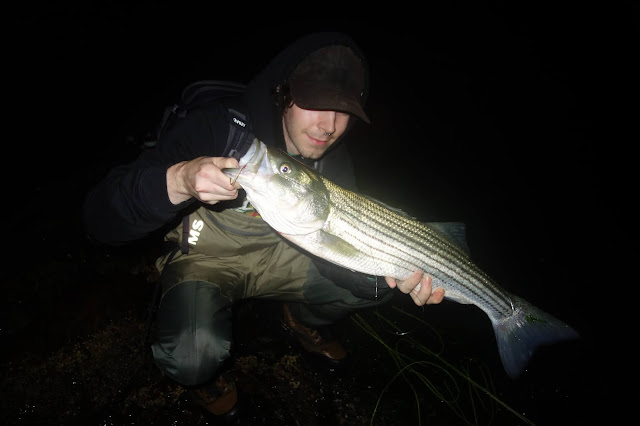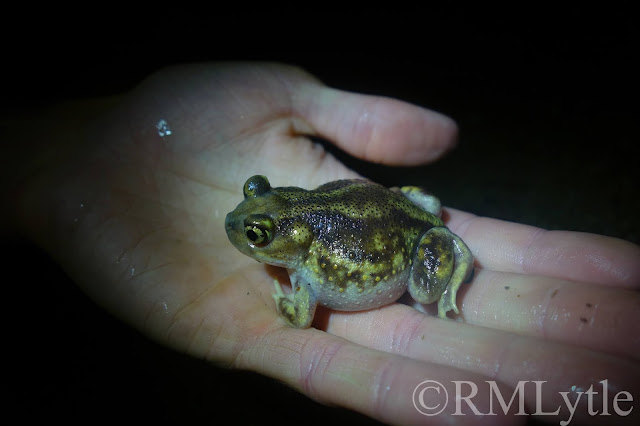We've had extraordinary amounts of rain in Connecticut this year. Perhaps too much rain, in many ways. Trout anglers who have long complained about diminished flows and low reservoir levels on the Farmington River got to see what the exact opposite does, as runoff flooded into the Colebrook and West Branch reservoirs and caused them to de-stratify; meaning there was no longer cold water at the bottom of those lakes and therefore no cold water to draw into the tailwater. The river ran warm for a very long time, and all the way from the dam in contrast to the typically frigid water that leaves the Hogback Dam most summers.
Some species benefited substantially from the rainfall and associated weather conditions. One of those species is possibly the most charismatic, strange, and magical frog in New England: the Eastern spadefoot toad. These animals spend the bulk of their lives in dark subterranean burrows of their own creation that range from a few inches to, in extreme cases, a good many feet below the surface. They remain dormant for months at a time but are summoned to the surface by heavy rainfalls associated with a significant barometric pressure drop. They then breed in massive numbers, using temporary pools to deposit their eggs. These eggs develop in as little as a day, and the tadpoles that emerge will metamorph into tiny bug-eyed frogs in just two weeks time.
Because Eastern spadefoots require specific sandy and loose soils for burrowing, breeding pools that may only exist for a few months throughout the whole year, and are very rarely on the surface to be seen, they have unfortunately been extirpated from many areas. In Connecticut they are now endangered. Gravel extraction, development, and road crossing mortality are the biggest factors in their demise. If it weren't for a handful of dedicated conservationists the number of spadefoot toads would likely be even smaller. When yet another big rain happened in the first days of September, I joined one of those people- herpetologist Dennis Quinn -on a mission to observe spadefoot toads and survey a property that could be holding them.
The night prior I'd payed a visit to a different area under Dennis' direction to try to see my first ever spadefoot. It was indeed the right conditions. The pressure had plummeted and it was pouring, like really pouring. The same storm system had produced a violent long-tracked tornado in New Jersey and though it was now messy and disorganized, there was a minor probability of a weak and isolated tornado in Connecticut. The rain was really coming down, harder than I'd ever driven in before. Lightning and strong wind added to the ambiance. I made my way to my destination very hopeful that I was about to finally see an animal I'd wanted to ever since I was a very young child. I got to the road Dennis told me to cruise, and sure enough 20 minutes in I saw the shape of a spadefoot in my headlights. In a mad rush I jumped out of the car and ran to the animal, and there in my flashlight beam was the coolest, strangest frog I'd ever seen.


I was floored, and that was far from the last spadefoot I'd see that night.
Having observed both adults and juveniles and gotten absolutely drenched, I headed home late that night to get some sleep. The next day I'd head out around sunset to meet Dennis in the same part of the state: this was the epicenter of Connecticut spadefoot activity. We drove around an area where he suspected some breeding pools might exist with the windows down, listening.
Now, I'd never heard a spadefoot call in person before. It was quite a familiar sound though. When I was little my parents gave me an audio device into which I could insert different cards, upon which were the calls of a variety of wildlife. Some of the cards were birds of prey, some were warblers, some were woodpeckers. One of the cards was all frogs, and one of those frogs was the Eastern spadefoot. I'd listened to every call on that thing hundreds of times, and most intriguing to me of all was the spadefoot's. Perhaps that was just because it was so strange and funny.
A spadefoot's breeding call is a very loud groan, a sound that is hard to describe yet familiar to many herp enthusiasts. It is so loud, actually, that rumor has it one population in Southern Connecticut was eradicated simply because the residents were annoyed by the frogs' incredibly loud calling. Whether that is true or not I can't confirm, but I can say that they are loud. When Dennis and I did finally approach a known breeding pool the trill was audible from quite a distance. We checked for calling activity at three pools, and upon confirming that all three were active we set out to survey a new property. The easement onto it turned out to be a little hard to locate. It was the edge of someone's lawn, and they'd put garbage bins and a brush pile right on the easement. We made it in without some angry homeowner shouting at us, then started surveying the property. Some common species were present, including grey tree frogs and a wood frog, but no spadefoots.
We did start to hear some calling which we though might be coming from the property. Dennis and I scoured the place only to determine that the callers- just a few males -were coming from somewhere off-property. Having done the job, we briefly tried to find the calling males as they were certainly not in a known pool. Frustratingly they went quiet so we ended up on the most well known pool in the area to document whatever activity was still occurring before the temperature drop shut things down. The pool was literally a flooded backyard, we walked right under that owner's living room window to access it. Dennis told me the story of the discovery of the breeding pool. Upon hearing the frogs calling in the backyard pool, the herpetologists walked to the house and could see a man seemingly sitting down and watching television. They knocked on the door and got no response, that is until the man's wife awoke and answered the door. It turns out both of them had been asleep. Surprisingly they were more than happy to let a bunch of headlamp-clad herpetologists look at their toads. They've allowed the biologists access ever since, and I was grateful for being able to accompany Dennis on the property. A few dozen males called from the pool and the grass bottom was covered in egg masses. Dennis also found some tiny metamorphs from the previous breeding event.



Throughout the night Dennis was on the phone with other herpetologists who were also out in the field observing spadefoots in various parts of the state. It seems that any time there's more than two inches of rain and a significant pressure drop, more than just the spadefoots burst into a flurry of activity. This was he third breeding event the herpetologists had observed in 2021. Three breeding events in a single season is almost unheard of.
In years to come I'm going to continue to be a part of this. Like so many species before, spadefoots have completely captivated me, and I feel compelled to help preserve and protect them and their habitat.
Until next time,
Fish for the love of fish.
Fish for the love of places fish live.
Fish for you.
And stay safe and healthy.
Thank you to my Patrons; Erin, David, John, Elizabeth, Brandon, Christopher, Shawn, Mike, Sara, Leo, C, Franky, Geof, Luke, Streamer Swinger, and Noah for making Connecticut Fly Angler possible. If you want to support this blog, look for the Patreon link at the top of the right side-bar in web version.

















































